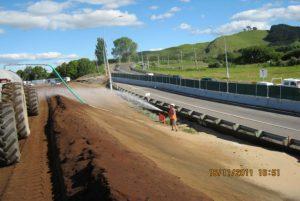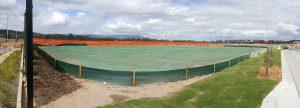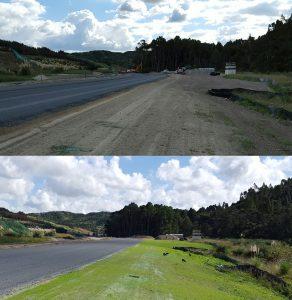Erosion Control
Soil and surface stabilisation practicesSoil binders
What, why, when and issues to look out for
What
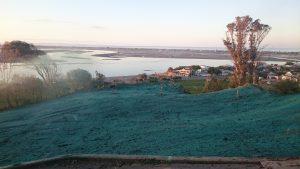
A well protected site where soil binding co-polymer was applied to significantly reduce erosion risk. The Estuary of the Avon and Heathcote Rivers / Ihutai is protected from sediment runoff from this site (Source: RST Solutions Limited).
Soil binders form a cohesive membrane or protective crust. This surface reduces windblown dust generation and reduces the erosive effects of rain impact by around 90%.
They might be liquid or powdered, and organic (eg guars, latex or various other timber resins) or chemical (eg acrylic copolymer, anionic bitumen emulsions or cementitious gypsum- or lime-based). They are sometimes called soil-stabilising agents.
Why
Soil binders are very useful against both wind and water erosion.
They prevent or reduce the movement of dust from disturbed soil surfaces, which is important because dust creates health hazards, traffic safety problems and off-site damage. Wind and weather patterns in Canterbury make us especially prone to dust problems, and since the quakes we have had an increased number of road works and construction sites which create dust.
Soil binders also significantly reduce the effect of raindrop erosion and so massively reduce sediment runoff. This has been established in rigorous research on loess soils (Erosion Control Treatment Trials on Port Hills Loess: Cashmere Catchment 2016, EOS Ecology Report No: ENV01-15035, August 2016).
Some soil binders are also included in hydroseeding or hydromulching operations to tack seed and/or wood fibre to the soil surface on steep slopes. A granular form of calcium or magnesium chloride may also be used to absorb atmospheric moisture and suppress dust on active haul roads and access tracks.
When
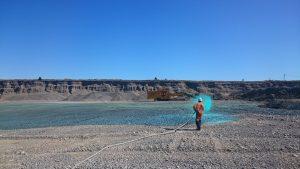
Dust suppression using soil binders/polymers at a large open cast quarry near Christchurch (Source: RST Solutions Limited).
Soil binders and chloride dust suppression agents are mainly used:
- For short-term protection – usually for less than 6 months – of stockpiles, steep or relatively unstable slopes, compound areas, and inactive haul roads
- When almost instant protection is needed against wind and/or dust erosion.
Issues to look out for
The following limitations apply to soil binders:
- Using a soil binder does not permanently stabilise a site. You still need to use other sediment controls until the disturbed land as been stabilised.
- For soil binders to be effective, their surface crust must stay intact. Keep construction equipment and site vehicles, pedestrians, wildlife and/or livestock out of all treated areas. Hardy colonising plant species, eg woody weeds, can also break through the crust.
- Do not use soil binders or chloride dust suppression agents on an area that has concentrated flow or where it is likely that periodic inundation will happen. Spray-on channel liners could be a good option here, as used in various types of drains, diversions, check dams and flumes, especially on erodible soils.
- Anionic bitumen emulsions, some acrylic copolymer emulsions and chloride dust suppression agents can pollute some sensitive receiving waters. In general, do not use these right beside streams or waterbodies.
- Be aware that community perception may be opposed to the use of bitumen emulsions.
Design essentials
There is no formal design procedure for soil binders, and products on the market are changing all the time. Follow these general principles:
- Coat areas evenly and well (according to manufacturers’ specifications), to ensure effective coverage. Failure and erosion can occur if binders are applied unevenly.
- Confirm with Environment Canterbury which products are acceptable for use.
- Follow the manufacturer’s recommendations for application rates and procedures.
- Document your Soil Binder Management Plan (SBMP).
Construction, operation and maintenance
When constructing and operating soil binders
- Intercept upslope runoff water and divert it around the areas that will have soil binders applied.
- Follow the manufacturer’s recommendations for the correct application procedure.
- Soil binders work best on friable (crumbling) soils. If necessary, lightly scarify the soil (break up its surface) to allow the binder to fully permeate the soil surface. (Note: Adding a wetting agent may also help).
- Soil binders are usually mixed with water before application. Stir or shake powdered products.
- Apply the solution over the area to be protected via the spray bar on a water cart, a hose with a fine spray nozzle, or through the cannon on a hydroseeder unit.
- Establish temporary exclusion zones around treated areas and clearly identify and/or signpost these. Discuss exclusion zones in routine toolbox meetings and at site inductions.
When maintaining soil binders
- Inspect soil binders weekly, after each rainfall and period of excessively strong winds
- Check for damage to the soil binder membrane caused by earthmoving equipment, construction vehicles, slips or slumps, inundation, ultraviolet degradation, livestock, wildlife or vandalism (motorcycles, four-wheel drives, etc)
- Check that soil binding agents have not been removed by excessive traffic movements, track runoff during wet conditions, routine grading or other haul road maintenance activities
- Repair any damaged areas immediately by reapplying the soil binder or covering with a temporary mulch or blanket
- If necessary, erect temporary barrier fencing and/or signage to restrict uncontrolled movement of equipment and vehicles onto treated areas
- Reapply as required to minimise dust generation and soil erosion caused by rainfall or wind.
